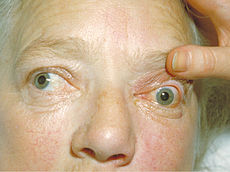- Exophthalmos
-
"Proptosis" redirects here. For the condition of drooping of the eyelid, see Ptosis (eyelid).
Exophthalmos Classification and external resources 
Patient with bilateral exophthalmos, as well as strabismus (asymmetrical eye alignment).ICD-10 H05.2 ICD-9 376.2-376.3 DiseasesDB 18612 MedlinePlus 003033 eMedicine oph/616 MeSH D005094 Exophthalmos (also called exophthalmia or proptosis) is a bulging of the eye anteriorly out of the orbit. Exophthalmos can be either bilateral (as is often seen in Graves' disease) or unilateral (as is often seen in an orbital tumor). Measurement of the degree of exophthalmos is performed using an exophthalmometer. Complete or partial dislocation from the orbit is also possible from trauma or swelling of surrounding tissue resulting from trauma. Trauma to the orbit can lead to bleeding behind the eye, a condition called retrobulbar hemorrhage. The hemorrhage has nowhere to escape and the increased pressure pushes the eye out of the socket, leading to exopthalmos or proptosis and can also cause blindness if not treated promptly.
In the case of Graves' disease, the displacement of the eye is due to abnormal connective tissue deposition in the orbit and extraocular muscles which can be visualized by CT or MRI.[1]
If left untreated, exophthalmos can cause the eyelids to fail to close during sleep leading to corneal dryness and damage. Another possible complication would be a form of redness or irritation called "Superior limbic keratoconjunctivitis", where the area above the cornea becomes inflamed as a result of increased friction when blinking. The process that is causing the displacement of the eye may also compress the optic nerve or ophthalmic artery, leading to blindness.
Contents
Exophthalmos vs. proptosis
Some sources define exophthalmos as a protrusion of the globe greater than 18 mm and proptosis as a protusion equal to or less than 18 mm. (Epstein et al., 2003). Others define exophthalmos as protrusion secondary to endocrine dysfunction and proptosis as any non-endocrine-mediated protrusion [1].
Causes
- Leukemias
- Orbital cellulitis
- Meningioma, sphenoid wing
- Dacryoadenitis
- Mucormycosis
- Dermoid
- Orbital fracture: apex, floor, medial wall, zygomatic
- Duane syndrome
- Carotid cavernous fistula
- Congenital glaucoma
- Eyelid ptosis: adult, congenital
- Nasopharyngeal angiofibroma
- Hand-Schuller-Christian disease
- Hemangioma, cavernous
- Thyroid ophthalmopathy (Graves' disease)
- High altitude cerebral edema (proptosis)
- Beckwith–Wiedemann syndrome
- Cushing's syndrome (due to fat in the orbital cave)
- aortic incompetence: manifests as a pulsatile pseudo proptosis, described by British cardiothoracic surgeon, Hutan Ashrafian in 2006
- Wegener's Granulomatosis
- Pfeiffer Syndrome
Exophthalmos in dogs
Main article: Eye proptosisExophthalmos is commonly found in dogs. It is seen in brachycephalic (short nosed) dog breeds because of the shallow orbit. However, it can lead to keratitis secondary to exposure of the cornea. Exophthalmos is commonly seen in the Pug, Boston Terrier, Pekingese, and Shih Tzu.
See also
- Boston's sign
- Enophthalmos
- Marty Feldman
- Von Graefe's sign
- Graves ophthalmopathy
- Heino
References
External links
Categories:- Dog diseases
- Disorders of eyelid, lacrimal system and orbit
Wikimedia Foundation. 2010.

